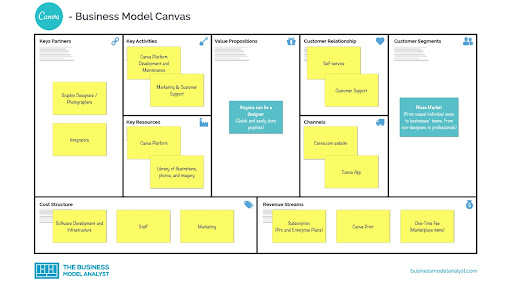Basics Elements For Developing Your Business Model Canvas
A business model canvas helps entrepreneurs analyze their business model from multiple perspectives. These factors include the cost structure, revenue streams, and customer personas. It is also helpful for entrepreneurs to share their analyses with a community or forum. If your want to scale your business using this business model canvas, visit this website.
Post Content
Scalability For Your Company
When creating a business model, it is important to think about how scalability will impact the business. If you have a business model that is based on a product or a service, you need to consider the scalability of the product or service. You must also consider the cost of development and implementation. The most important costs should be identified early on.
The value proposition is one of the most important elements in a business model. It helps you identify the customer’s needs. It is the driver of most business models. You can learn more about Personas in our Tutorial Personas. This article will explain how you can use these elements in your business model.
The ability to scale up a business is key to its success. As the market grows, so does the amount of money that can be made. The ability to scale effectively allows businesses to achieve higher profits while maintaining the same level of costs. By scaling up a business, they can increase production and reach new markets without hindering their structure.
To maximize scalability, businesses should focus on their strengths and outsource peripheral tasks. The top companies are experts at leveraging external resources.
Customer segments
One of the most important components of the business model canvas is the Customer Segments building block. It outlines the demographics, purchasing behaviors, and pain points of specific customer segments. After selecting a customer segment, you will need to build a value proposition that addresses the specific needs of this group of people. This is the first step in developing a business model.
Segmenting your customers is essential for successful marketing. You should consider the needs and wants of each group to determine which features, products, and services will be most valuable to each group. In addition, you can create customer segments based on geographic location or psychographic characteristics. These segments can guide your sales conversations with each segment.
The mass market segment is the broadest and includes most consumer products. It can be further segmented to identify slight differences in customer needs. This allows you to better serve the specific needs of each segment. For instance, if your target audience is price conscious, you may want to target this segment.
Customer segments are the most important components of a business model canvas. Without them, a business can’t exist. Customer segments are like demographics.
Cost structure
Cost structure is one of the key components of a business model. Many new businesses fail because they don’t properly allocate costs. Identifying all costs related to your product, service, or industry will help you establish an accurate cost structure. After identifying all resources, activities, partners, and expenses, you can assign costs to different cost objects. Your cost structure should be reviewed and updated regularly to ensure that it is still meeting your expectations.
The cost structure of a business model includes all costs associated with creating value propositions, maintaining customer relationships, and generating revenue streams. It is much easier to define the essential activities and resources than defining the costs of each. Once you have defined these costs, you need to allocate them across all product and service offerings.
To create your business model, you need to identify the elements that are important to your product or service. These elements should align with each other. You should place your value propositions in the center of the canvas. By doing so, you’ll be able to separate the front stage from the backstage.
Another key factor in cost structure is the amount of fixed costs versus variable costs. Companies with high fixed costs typically have less downside risk and higher upside potential. Large companies with large production quotas typically have low variable costs. These costs are often low because of economies of scale. They also share processes and resources across products, which decreases the average cost per unit.
Revenue streams
When building a business model, it is important to think about your revenue streams. These can be recurring or transactional, and they can include sales of products and services. Transactional revenue streams result from one-time transactions, while recurring revenue streams are derived from ongoing payments. Some examples of revenue streams are asset sales, leasing or renting, subscription fees, licensing, and advertising.
When developing a business model, organizations must determine their customers’ willingness to pay for their products and services. They must also define their revenue streams, or key resources. These will determine profitability. When designing revenue streams, make sure to think about the future state of the company, including the life cycles and pricing mechanisms.
Revenue streams on a business model canvas represent the various ways a business can generate cash from different segments of its customer base. For example, a subscription-based business would have a subscription revenue stream, and a start-up would have multiple revenue streams. A digital business may have more than one revenue stream, and different streams will involve different pricing mechanisms.
When designing revenue streams, consider what type of revenue is most predictable and stable. Recurring revenue depends on a stable customer base, while transactional and service revenue fluctuates with the demands of each customer. Project revenue is more volatile, as it depends on the relationship between a business and its customers.
Customer personas
When creating customer personas, you need to understand what motivates them. While these goals will change from one segment to another, they underpin the overall direction of a persona. Goals are also important to segmenting, because they will help determine what you focus on. Once you understand what motivates your customers and users, you can build your customer journey and value proposition.
Start by creating a list of your customers’ problems and needs. List their problems, and think about your product or service’s value propositions. Next, rank those problems and needs. Then, winnow out the less important ones. This way, you’ll be able to create customer personas that are more helpful to your business.
Customer personas are a great way to understand who your customers are and what they’re looking for. You can use CRM data or analytics tools to help you define your target audience. You can also use your best guess and create a persona based on your own experience. The best customer personas will incorporate elements from all of these sources, and they should be specific to your product or service.
You can also use customer personas to identify the problems facing your target customers. These problems are largely driven by your value proposition. For example, if you sell products or services that solve a customer’s problem, you should create a customer persona that addresses their pain points.
ful for larger companies that need to develop new models or scale their existing ones.




